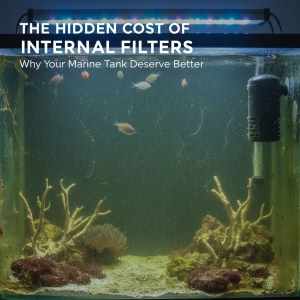Why is Live Rock So Expensive? - The Reason Is Simple!
Welcome to Simple Reefs. We have been talking about Live Rock, Dry Rock, and Life Rock, as part of our series on starting your own marine aquarium. We talked about the differences between them and the benefits of live rock but we also, briefly, touched on the price which begs the question. Why is Live Rock so expensive?
Let’s imagine a scenario. You are taking the plunge and starting your own marine aquarium. You have decided that, as we have recommended, the most affordable option is to grab some Dry Rock and then add a decent sized piece of Live Rock from your local fish shop to speed up the process of transforming your Dry Rock from a barren wasteland into an active mass of varying lifeforms.
Note: Please keep in mind that Simple Reefs is a very new website. Some information may be incomplete, some links may not be active, and some articles may be unfinished. Please bear with us while we build.
Awesome, you are about to save a bunch of money. But as you approach the Live Rock section of your fish shop. You notice a sign that says “Live Rock, £17 Per Kilo“. You just about pass out at how ridiculous that price is. One kilo? The smallest piece in there might weigh three. That’s as much as you spent on the dry rock for one piece of live rock. What the hell?
What is With The Price of Live Rock?
It’s quite simple and the reason might make you feel a little better about dishing out the extra cost. It’s down to conservation. Live Rock used to be actively harvested from ocean reefs. It was both cheap and plentiful. Naturally, this came at the cost of the health of the reef. Live Rock is created over a long time period and replacing it is not an easy or quick task. Thankfully, attitudes have changed and reef preservation is far more important. Meaning that it is far less common to see ocean harvested rock appearing in fish shops.
That does mean, however, that finding Live Rock is more difficult and it costs more money. Fish shops now have to, basically, produce their own live rock. This means they have to take some Dry Rock and place it into an aquarium with an already established collection of Live Rock. This will, then, transform the dry rock into Live Rock as the bacteria reproduces and populates its surface. Eventually being joined by small invertebrates and other such creatures.

The problem, here, is that it takes a long time. A hell of a long time, in fact. For a piece of dry rock to become properly live. You could be looking at a couple of years. To have an extensive collection of algae, sponges, invertebrates, and more, may take upwards of three years. I started with bright white dry rock in my main tank, eventually adding a large piece of live rock, and it took over two years for it to look truly live.
There really isn’t much profit to be made, here. Dry Rock is already quite pricy. Housing it for years costs money. Meaning that prices have skyrocketed. Fish shops just don’t see the profit in it anymore. It takes up a lot of space, takes a lot of time to produce, doesn’t earn much money and can even cause issues with buyers who find themselves disgruntled because the rock had a few nasties on it. It just isn’t worth it.
Shady Practices
Even worse than the huge price is the fact that a lot of live rock sold at fish shops isn’t live at all. It is dry rock that is weeks old and just so happens to have been sitting in the water for awhile. Sure, it won’t be dead but it certainly won’t feature the menagerie of bacteria and invertebrates that you would actually want in your tank. Hell, the only thing it may feature is some of the bad stuff that you absolutely don’t need in there.
I was eyeing up a nice piece of dry rock at a fish shop a few years back. It had dozens of little holes, was very porous, and looked absolutely fantastic. I figured I could put it in my sump, let it become live and then add it to my tank in the future. I didn’t, actually, get around to buying it but, only a month or so later, I found it in the “Live Rock” pool being sold for exponentially more. It was still bright white and could hardly be counted as “Live”. This was in the same fish shop that I saw a boxing shrimp helping itself to the many Halloween Hermit Crabs they had foolishly placed in the tank with it.
Disappointingly, many of the fish shops around are in it purely for money. The high price of live rock means there is a lot of incentive for them to do this. Dry Rock can be sold at a much higher mark up. Most inexperienced hobbyists won’t know the difference and the people that do won’t complain because they won’t be the ones buying it. It is a shady practice but very common.
What Can I Do?
The simple answer is to turn to the hobby community. Tons of people are more than willing to help newcomers to the marine fishkeeping hobby. There will, almost certainly, be someone close to your area willing to offer a rock or two to get you started. They will also have a bunch of good advice and may become your best friend when it comes to marine fishkeeping. An experienced ear is always useful when you have problems.
If this is out of the question. I would suggest purchasing the smallest, most affordable, piece of live rock that you can. You don’t need an epic sized piece to get started. Something small will do. Place it up against your other rocks and then be patient. The bacteria will reproduce and populate your dry rocks. Eventually turning them into a burgeoning ecosystem of their own.

Just be careful when making your purchase. If the rock you are looking at is white, or an off-white, it is unlikely to be very live at all. In fact, it may have only been in the water for a few weeks. When you buy that and take it home, it won’t introduce many positive organisms into your tank and may even release a whole bunch of silicates which will fuel diatom growth. A brown, dusty, type of algae that feeds on silicates to help create it’s silica cell walls. You will encounter diatoms in a new aquarium anyway but you don’t want to make the problem worse.
In Short
Exercise caution when purchasing live rock. Especially if you are looking to build a budget marine aquarium. It is uneconomical to create your entire rock scape using live rock thanks to the increased prices as a result of the conservation of reefs. Pick a reasonable sized piece that appears to be free of anything nasty, has a deep brown colour that suggests it is well aged, preferably has a decent amount of coralline algae on its surface and maybe even a few invertebrates. Don’t be afraid to ask fellow hobbyists for help. Many will be more than willing to give you a few rocks or something to get you started.








